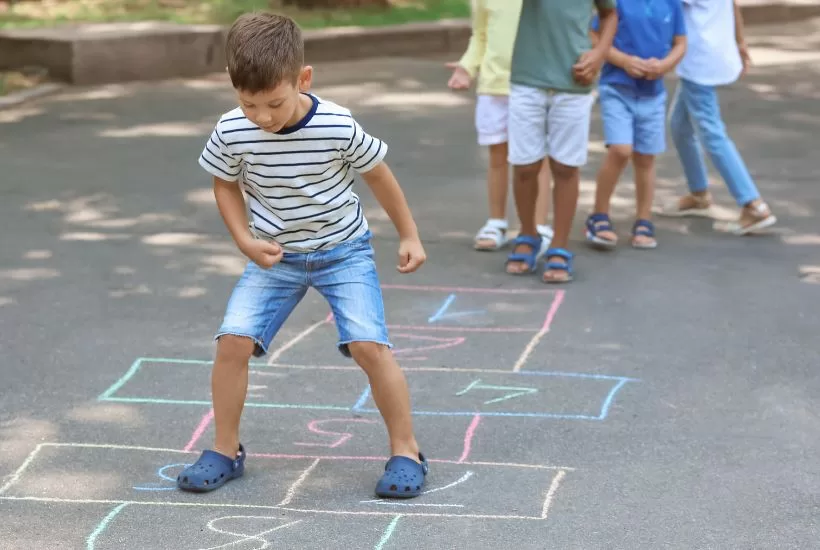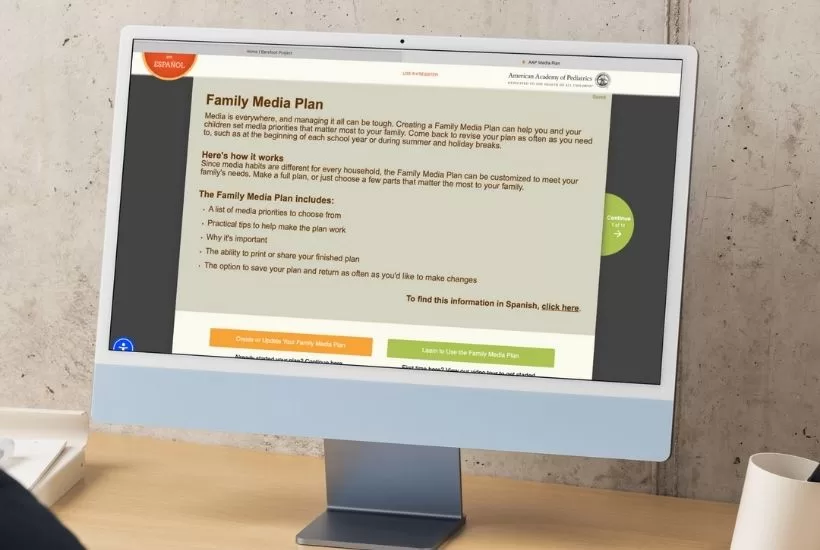A Parent’s Guide to managing screen time over the Holidays
Picture this: It’s the holiday season, a time meant for joy, togetherness, and the occasional sibling argument over who really broke the gingerbread cookie first. The kids are home, the fridge is somehow always empty (how are they hungry again?!), and the tablets are on their third charge of the day. Meanwhile, you’re quietly wondering if screen time limits are more of a “during the school year” thing—like packed lunches or being able to find both socks. Sound familiar?

You’re not alone. Managing screen time during breaks feels like a lose-lose situation: either you become the screen police (complete with cries of “You’re ruining my life!”), or you give in and let them play until their eyes glaze over and they start calling you “Alexa.” And let’s be honest: neither option really screams “holiday magic.”
But don’t worry—there’s a middle ground. This post is here to help you strike a balance between screens, sanity, and those fleeting moments of holiday joy. With a mix of humor, practical tips, and a little bit of brain science sprinkled in, we’ll navigate this digital holiday jungle together. Because if the holidays are about anything, they’re about survival—and maybe, just maybe, creating some screen-free memories. Let’s dive in!
The Parent Coach’s Perspective: Balancing Fun and Structure
“As a parent coach, I’ve had more parents sigh over screen time than over bedtime battles. And that’s saying something!” Screen time is one of those topics—right up there with “What’s for Dinner?” and “Why does everyone leave their socks in the living room?” The holidays seem to magnify the struggle as routines dissolve into gingerbread crumbs and late-night movie marathons.
The key isn’t rigid limits but finding a balance that works for your family. Here’s how you can keep screens from taking over the holidays (while keeping your sanity intact):
1. Focus on a Balanced Day, Not the Clock
Instead of sticking to a strict “two hours of screens” rule (which can feel impossible some days), think about balance. Has your child spent time doing other activities—playing outside, crafting, reading, or helping bake cookies? If their day includes a mix of creative, physical, and social activities alongside screens, you’re doing great. Some days will naturally lean heavier on screens, and that’s okay too—it’s the holidays, not a military boot camp.

2. Involve the Whole Family
No one likes surprise rules, especially kids. Sit down and talk about how to balance screen time together. Maybe you agree on a “screen pause” during meals or family activities, but also recognize that downtime with a favorite show or game is part of the fun. When kids feel included in the decision-making, they’re less likely to rebel (or at least, they’ll argue slightly less).
You can even create a family media plan together using resources like HealthyChildren.org’s Media Plan. This helps everyone get on the same page about screen time and make it a collaborative process.

3. Offer Fun Alternatives
Screens are tempting because they’re easy—and let’s face it, they keep the peace. But you can create just as much excitement with offline activities: a cookie-decorating contest (yes, sprinkles everywhere!), a holiday scavenger hunt, or building a pillow fort. If you’re really ambitious, try organizing a family karaoke session—holiday carols, anyone? The goal isn’t to eliminate screens but to remind everyone (yourself included!) that there’s joy to be found beyond the glowing rectangle.
Ultimately, holidays are about connection, not perfection. Some days the balance will look Pinterest-worthy, and other days, well, Mario Kart may just save the day. And that’s okay—because a balanced holiday isn’t about what your kids don’t do; it’s about everything they do.
The Psychology Perspective: Understanding the Bigger Picture
“Kids + Screens + Holidays = A perfect storm of overstimulation and parenting guilt.”
Let’s face it: the holidays are stressful enough without adding the very real pressure of monitoring screen time. The thing is, screens are so much more than just “easy distractions”—they’re designed to hook kids in, often in ways we don’t even realize. And, if we’re being honest, it’s hard to say no when you’re trying to make the holiday season feel magical for your family.
Why Screens Are So Tempting
Kids’ brains are wired to seek novelty and rewards. It’s a great survival mechanism—new things and rewards usuallymean something good. Games, shows, and apps are designed with this in mind, using rapid rewards and stimulating graphics to keep kids glued to the screen. The flashing lights, fun sounds, and instant gratification are like a dopamine buffet, making it hard for kids to turn away. So yes, that “five more minutes” turns into hours… and suddenly, you’re bribing them with a cookie to take a break.
Why Balance Matters
While screens can be fun (we all know how quiet and peaceful it can get when they’re absorbed in their favorite game or show), too much screen time can lead to overstimulation and meltdowns. And, you guessed it, holiday meltdowns are memorable… but not in a Hallmark movie way. The overstimulation can mess with sleep schedules, irritability spikes, and, let’s be honest, no one wants to spend Christmas dinner refereeing a battle over who gets the iPad first.
That’s why balance is key. It’s about finding those moments of peace where they can reset and recharge—not just from screens, but from the holiday hustle too.
Strategies for “Screen Breaks”
One of the easiest ways to encourage screen breaks is by creating a Holiday Activity Bucket List. Think of it as your holiday survival guide—one that gets everyone away from the screens and into some fun, off-the-grid moments. The best part? It takes the pressure off deciding what to do next. You already have a list of activities ready to go, so there’s no more “I’m bored!” whining or scrambling for something to do.
Here’s how it works: create a list of 15–20 simple, screen-free activities to do over the holiday break—just one or two things per day. It could be anything from a DIY ornament craft session to a holiday scavenger hunt around the house. Want bonus points? Add a couple of “outside” activities (like a snowball fight or nature walk) to reset their brains and get them moving.
Not only does it give kids something to look forward to every day, but it’s a great way to sneak in some quality family time while also hitting the reset button on those overstimulated minds. You get a break from feeling like the “activity coordinator,” and they get a fun mix of holiday moments and memories they can look back on.
So, instead of battling it out over screen time, you’re creating a whole lot of offline joy. Plus, when the screen time does happen, it’ll feel more like a treat, not the main event.

When You Have a Toddler, Preschooler, and Teenager
Balancing activities for a toddler, preschooler, and teenager can feel like juggling three different worlds, but with a little creativity, it’s totally doable! Here are some screen-free activity ideas that can keep everyone entertained, regardless of age:
1. Family Dance Party
Turn up the holiday tunes and have an impromptu dance party! Toddlers can wiggle and shake, preschoolers can learn new moves, and teenagers can show off their best choreography. It’s a fun way to get everyone moving, laughing, and together.
2. Holiday Craft Station
Set up a crafting station with a mix of simple activities for all ages. Toddlers can color or glue stickers, preschoolers can make paper ornaments, and teenagers can design more intricate holiday decorations or cards. You can all work on creating a holiday masterpiece together.
3. Baking Together
Baking cookies or treats is a fun, interactive activity that can involve everyone. Toddlers can help with simple tasks like stirring or pouring, preschoolers can decorate cookies, and teenagers can help with the more detailed tasks like mixing or baking. Plus, everyone gets to enjoy the results!
4. Family Storytime & Puppet Show
Read a holiday story together and let your older kids (even the teens!) act out parts of the story with toys or homemade puppets. Toddlers will love the interaction and the animated voices, while preschoolers and teens can add their own creative spin to the performance.
5. Holiday-Themed Scavenger Hunt
Create a scavenger hunt where each child can have a task suited to their age. The toddler might look for a specific color or object, the preschooler can solve a simple riddle or find matching items, and the teenager can help hide the clues or organize the whole hunt. It keeps everyone moving, thinking, and having fun together.
With a little flexibility, these activities can be enjoyed by all ages while keeping everyone engaged in the holiday spirit—screen-free!

Validation for Moms
And moms, let’s get real here: Your kids don’t need to learn to code during every screen session to make it “educational.” Let them enjoy a game for the pure joy of it. The holidays are about relaxation and connection, and sometimes the best thing you can do is let them enjoy a game or show without the pressure of making it a learning experience. (And yes, you’re still a great mom if your kids spend some time doing absolutely nothing productive in the tech world!)
In the end, it’s all about balance—balancing fun and downtime, screen time and sensory resets, and yes, the guilt and the joy that comes with it. After all, holidays are about making memories, even if those memories occasionally involve some screen time.
The Neuroscience Perspective: What’s Happening in Those Little Brains
“Ever wonder what’s going on in your child’s brain when they’re deep into a game like Minecraft? (Spoiler alert: it’s a lot like what happens to us when we can’t stop scrolling Netflix!)”
When kids play video games, their brains get a boost of dopamine, the same “feel-good” chemical that makes them want to keep playing, much like how we feel when we finally start a new binge-worthy show. This isn’t necessarily a bad thing—dopamine is part of how our brains motivate us to keep going. But like all good things, too much of it can lead to issues. Let’s dive into what happens behind the scenes when kids are glued to their screens.
Dopamine Dynamics
Here’s the deal: screens are basically designed to trigger that sweet, sweet dopamine hit—yep, the same thing that makes us all just one more episode people. When kids interact with games or apps, every little win (like leveling up in Minecraft or collecting virtual coins) releases dopamine, creating a cycle of instant gratification. The problem? Their brains are soaking up dopamine like sponges, which can make it hard for them to stop. You know that moment when they insist they’re “almost done,” but five more minutes turns into another hour? Yep, that’s the dopamine loop at work, and it’s hard to break free from.

The Impact of Screen Time on Focus and Mood
Ever noticed how your kid acts like a raccoon coming down from a sugar high after three hours of Roblox? Yeah, that’s the prefrontal cortex having a meltdown. Here’s the science: the prefrontal cortex, which is responsible for focus, decision-making, and emotional regulation, gets a little overloaded after too much screen time. When they’re on their device for hours, their brain’s ability to focus starts to decrease, and they may get a little… um, cranky. It’s like their emotional batteries are drained, and suddenly, it’s meltdown central over a forgotten snack or losing a game. The good news? Balance and breaks can help reset the prefrontal cortex, restoring their ability to focus and regulate mood.
Why Sleep is Sacred
Sleep might feel like an afterthought during the holiday madness, but it’s actually the brain’s most important reset button. Here’s why: when kids are exposed to blue light from screens, it messes with the production of melatonin, the hormone that helps them fall asleep. Essentially, their brains think it’s still daytime, even when it’s midnight and they’re asking for “just one more game.” Lack of sleep not only affects their mood and energy but also their ability to focus and learn the next day. So, if you’ve ever struggled to get them to bed after a screen-filled day, blame the blue light—and maybe add a few extra bedtime stories to help them unwind.
The Upside of Video Games
No formal research has been conducted specifically on Minecraft, but there’s plenty of research showing that video games—yes, even the ones that involve building things or collecting coins—can have both positive and negative effects on kids. In fact, research suggests that video games can improve skills like processing speed, working memory, problem-solving abilities, and even pro-social behaviors. Some strategy-based video games can stimulate cognitive flexibility, essentially helping kids’ brains build new pathways. So, while too much screen time can overload their little brains, a good balance might just enhance their cognitive skills and even help them become better problem solvers (maybe even better at cleaning their room—we can dream!).
So, the moral of the story? Moderation is key. Too much screen time can overstimulate their brain, disrupt their mood, and mess with sleep schedules. But a little balance—and a well-timed screen break—can do wonders for their little brains… and for your holiday sanity!
A Game Plan for Moms: Practical (and Sanity-Saving) Tips
As a mom, you’re juggling a lot during the holidays—decorating, hosting, cooking, and managing the chaos of kids on break. Add screen time into the mix, and it can feel like you’re losing control. But fear not! I’ve got some practical, sanity-saving tips to help you maintain balance, keep the peace, and still enjoy the holiday season without getting caught in a screen-time battle.
1. Customize Screen Time Based on Energy Levels
Rather than a strict “two hours a day” rule, try assessing your child’s energy and engagement levels. If they’ve been running around outside or helping with holiday prep, a little more screen time might be fine as a wind-down. On days when they’ve been less active, consider offering more offline activities. Flexibility allows you to make sure they’re staying active and engaged in a healthy way, without rigid rules that lead to frustration.
2. Set Screen-Free Zones
Designate certain areas and times as screen-free zones. For example, the dining table is for family meals and conversation (no devices allowed!).
This gives kids—and you—a break from constant screen interaction and encourages face-to-face connection, which is especially meaningful during the holidays.
3. Be the Role Model (or at Least Try)
As much as we love to tell kids to “put down their phones,” it’s tough to expect them to do so if we’re constantly glued to ours. Try to model balanced screen habits yourself—whether it’s limiting your own Netflix binge or putting the phone down when you’re talking to them. You’ll have a lot more luck encouraging them to take a screen break if you’re taking one yourself.
Key Takeaways:
- Balance Over Rigid Limits: Instead of strict screen time rules, focus on balancing screen activities with other activities like playing outside, crafting, and family time. Flexibility is key during the holidays, and some days may naturally involve more screen time than others.
- Family Involvement: Involve the whole family in setting screen time rules. This reduces resistance and creates a sense of cooperation. For example, you can agree on screen pauses during meals or family activities.
- Fun Alternatives to Screens: To keep kids engaged offline, try activities like cookie decorating, scavenger hunts, karaoke, or a family dance party. These can be just as fun as screen time and create lasting memories.
- The Psychology of Screens: Kids are naturally drawn to screens due to their ability to offer rapid rewards and instant gratification (dopamine release). However, too much screen time can overstimulate their brains, causing mood swings and disrupted sleep.
- Neuroscience Insight: Extended screen time affects kids’ ability to focus and regulate emotions, as it overloads their prefrontal cortex. Moreover, the blue light from screens interferes with melatonin production, affecting sleep.
- The Power of Screen Breaks: A “Holiday Activity Bucket List” can help combat boredom and overstimulation by providing planned activities that encourage offline interactions, family bonding, and cognitive resets.
- Managing Different Age Groups: For families with multiple age groups (toddlers, preschoolers, and teens), adapt activities so they’re fun and engaging for everyone. Options include baking together, crafting, or organizing a family storytime.
- No Guilt in Screen Time: It’s okay for kids to enjoy some screen time during the holidays, even without it being “educational.” The holidays are about relaxation and making memories, not perfection.

Conclusion: The Magic Word – Moderation
Let’s face it: the holidays are chaotic, and so is screen time. But here’s the thing: it’s all about finding that sweet spot between a little extra screen time and the joy of old-school activities, like building snowmen (or Lego towers) and indulging in holiday treats. Moderation is the magic word—too much of anything, whether it’s screens or gingerbread cookies, can lead to meltdowns, but just the right amount makes everything feel balanced and fun.
As a parent, you’re not expected to have the perfect balance every day (because, let’s be honest, even the most well-thought-out plans get tossed aside when cousins come to visit!). But by being flexible, involved, and creative, you can set the stage for a holiday season where everyone gets to enjoy screen time without losing their minds—or their connection to each other. Happy holidays, and may your days be filled with the perfect mix of tech-free magic!






